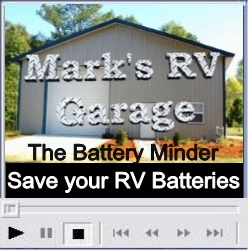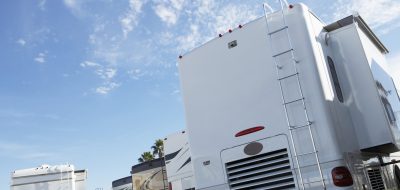 The topic of RV batteries seems to come up a lot among RVers, and there is good reason for it. Did you know the average life for RV batteries with limited battery care and maintenance is only 2 to 3 years, and that 85% of all 12-volt batteries manufactured die before they should? That can get expensive, replacing two or more deep cycle batteries at a time.
The topic of RV batteries seems to come up a lot among RVers, and there is good reason for it. Did you know the average life for RV batteries with limited battery care and maintenance is only 2 to 3 years, and that 85% of all 12-volt batteries manufactured die before they should? That can get expensive, replacing two or more deep cycle batteries at a time.
If you really think about it it’s not just RVers who have to deal with battery problems; if you have a riding lawnmower, a motorcycle, a golf cart, an automobile, a boat or an RV you have probably experienced problems with batteries at one time or another.
Some of the reasons for these battery problems are undercharging, overcharging, not recharging a discharged battery in a timely manner, lack of maintenance, and a lack of understanding what is required to properly maintain batteries.
The #1 cause of battery failure is a condition called sulfation. When a battery is improperly charged, overcharged or undercharged, or allowed to self discharge small crystals of sulfuric acid from the battery’s electrolyte start to form on the charge plates. Over time this sulfate material cannot be converted back into active plate material and the battery is ruined.
This also occurs when a battery remains discharged for an extended period of time. These crystals act as a barrier, stopping the battery from ever accepting a full charge again regardless of how long you charge the battery. Once this happens, the power and longevity of the battery is severely reduced and your battery becomes one of the 85% that die before it should. Sulfation begins when a battery’s state of charge drops below 80%, or 12.4 volts.
I mentioned a moment ago that overcharging was one reason for batteries dying early. This is a common problem with RV’s. The RV converter has a built in battery charger and most owners are under the impression that if you leave the RV plugged in when it is being stored it will keep the batteries topped off. Keeping the batteries topped off is extremely important, but the problem is many RV converter chargers provide a constant charge of about 13.5 volts which is too high for fully charged batteries. When this happens the electrolyte is boiled off resulting in an early death for the batteries.
Another problem is not charging the batteries at all when the RV is in short or long term storage or not recharging a discharged battery in a timely manner and letting it sit in that condition for extended periods of time. Both of these problems result in early battery death too.
Even for someone with a decent understanding of batteries and battery maintenance I had a few batteries that became statistics in the past. Then I discovered a way to prevent all of these battery related problems for good. It was a product that charges, maintains and conditions the batteries.
There are a few of these products on the market. The one I use is called The Battery Minder. What I mean by conditioning the battery is that the manufacturer of The Battery Minder has developed a simple but extremely effective circuitry that can safely dissolve the sulfation on the plates and restore much, if not all of the lost power. The reason The Battery Minder works so well is because it not only charges the battery, it maintains and desulfates the battery and will never overcharge the battery.
I’m not saying that you will never have to check the water levels or routinely inspect your batteries again, but this product will simplify your battery maintenance and extend the life of your batteries. It can even reverse sulfation on batteries that are already affected by this condition, if caught in time. It’s not very often that I endorse a product but The Battery Minder is one that I have been using for many years now, and through using it I have seen proven results.
When I’m not using the RV I hook the battery minder up and let it go. Through proper charging and maintenance you can easily double the life expectancy of your RV batteries.
Happy Camping,
Mark Polk
RV Education 101






Bob
Mark,
Thanks a lot, this makes much more sense. Now I can put this plan into action and save some $$$$ in NOT purchasing batteries needlessly or sooner then needed.
Thanks for all you input and assistance.
Bob
Mark Polk
Bob,
If you only want to maintain the batteries from low use drain what I would do is use a solar charger for the house batteries and then get a product like the Trik-L-Start for the chassis battery(s).
Let’s start with the solar charger. If the batteries are fully charged when you park the RV all you need to worry about is keeping them topped off and not over charging them. This would basically be a trickle charge. To do this you would want the solar charger wattage to be about 0.3% of whatever the battery bank in the RV is.
Watts = Amps X Volts
For example if you had a 200 amp hour battery bank (all batteries combined) the first step is to take 200 X 0 .3% = 0.6 Now you multiply 0.6 Amps by the voltage of the battery system to determine the solar panel Watt size required. If it’s a 12 volt system it is 0.6 X 12 = 7.2 Watts. This would be the panel Watt size for the battery size used in the example. You could easily get away with using a 5 Watt panel just to provide a trickle charge to a system like this.
Now let’s talk briefly about the Trik-L-Start. It is easy to connect, it operates on 12 volts and it will never over charge the chassis batteries. It actually steals a small amount of current from the house batteries and uses it to keep the chassis batteries charged. The house batteries have to be charging for the Trik-L-Start to work, so if you have the house batteries connected to a solar charger it would work fine. It stops working whenever the house batteries are not being charged. So basically it would work when you are plugged into electricity, running the generator, or when a solar charger is connected.
Bob
Thanks for the advice Mark. I got a couple of follow ups;
1. What size of Solar panel is sufficient to keep the batteries charged?
2. Will the solar panel overcharge the batteries?
2. Will one solar panel do all 3 batteries (2 house & 1 chasis)?
I also plan on just running the engine periodically also, I agree running the engine helps lube it and bringing it up to temp keeps it tight from other leaks.
Thanks for all your help
Bob
Mark Polk
Bob,
Some higher end motorhomes have an additional charge circuit from the converter charger to the chassis battery, but most don’t. So in most cases the chassis battery is not being charged by the converter charger when the generator is running.
If the batteries are fully charged when you park it a solar charger should keep the batteries topped off while it is in storage. Even with a battery disconnect to prevent parasitic loads from discharging it, a battery will self discharge over time. Iif you don’t have some type of charge going to the chassis battery I would recommend starting and running the engine periodically. Starting it once in a while also helps to lubricate the engine etc.
Bob
Hi Mark,
Well I’ve joined the 85% club who lost batteries too soon. What I have is a motorhome in a storage facility. There is no power available in the lot. So I would use the house battery disconnect switch and leave them at that. What I found was one day I went out to the motorhome and the chasis battery was dead. I hit the emergency button to start the motorhome and nothing happpened. I went back and was able to start the onboard generator so I thought the house batteries were fine. It also seems the generator does nothing to charge the chasis battery, is this true? At this point I thought the emergency switch failed. I had it cheked and the tech told me one of the house batteries was gone and the other was not too long for this world. I had the batteries replaced with fresh ones.
What I’d like to know is in my case would a solar panel keep the house batteries AND the chasis battery charged sufficiently? Do I need separate solar panels, one for chasis and one for house batteries? Does it make sense to purchase a battery disconnect for the chasis battery? I live in an area where goign to the RV is not problem it’s located very close. We have very mild winters here in California. Does it make sense to periodically run the engine and charge things up? I want to avoid replacing batteries if I can somehow prolong their life and am looking the best procedure to accomplish this, you suggestions would be greatly appreciated.
Eric Strom
Thank you Mark. I’ll do just that.
Mark Polk
Eric,
It’s difficult to say what condition the battery is in after losing some or all of the electrolyte. Take it to a battery shop and get an experts opinion on the condition of the battery.
Mark Polk
Thomas,
Normally batteries will last longer if you don’t cycle them quite so deep before recharging them. Many of the converter chargers used on RV’s are not very sophisticated battery chargers. They use a low amount of amperage from the converter for the job of charging the batteries and charge at a constant rate, usually around 13.5 volts.
Some of the newer converters are actually 3 stage chargers and do a much better job, so it depends on ythe type of converter charger you have.
Mark Polk
John,
In your situation a solar charger is about the only way to keep the batteries topped off. Your solar charger on top the A/C unit is probably just for the house batteries.
If you have battery disconnect switches make sure they are off to prevent any parasitic loads from draining the batteries, and if you can periodically go to the storage lot and start and run the engine for a while.
Mark Polk
Gerry,
The Cummins engine more than likely uses two 12 volt batteries wired in parallel to increase the Cold Cranking Amps (CCA) of the batteries. The motorhome should have an auxillary battery start switch that you can use to try and start the engine with the house batteries . It will depend on the condition of the house batteries, but hopefully the solar panel kept them topped off.
It’s difficult to say how long it would take to charge the batteries, and if they will take a charge. At 11.7 volts they are completely discharged.
You may want to plug the RV in and let the RV charging system charge the house batteries for awhile.
Eric Strom
Okay, reading these comments, and your blog post, I realize not only am I still a total newby to RVing… but relatively stupid when it comes to the batteries. I purchased my current battery last August. (I lost the first one… that’s a long story!)
Here’s my question: After a recent 2 week vacation, I pulled the battery from my trailer, as there’s no power in the storage lot, and frankly I don’t trust the other users of the lot. I put the battery in the back of my tow vehicle… and then forgot it was in there. At some point, the battery tipped over on to it’s side. I didn’t notice until I saw liquid leaking from the bed of the truck. I’ve cleaned all that up, but as to the battery, I always assumed “no maintenance” meant just that.
Do I just add water to the battery to replace what leaked out? Or do I need to take it somewhere to have something special put in? Or do I go buy a new one?
See? When it comes to batteries, I’m a moron (hopefully, that’s limited just to batteries….)
Thomas Becher
How much current does the avg converter put into the battery? I asked(emained the manufacture ) but havn’t recieved a reply. When boondocking my batterys get down to 101/2 – 11 volts before I start my generator to recharge. My last batterys lasted 5 years. I accidently let them freeze, but I still used them for 3 months after that. I use 2 12 volt deepcycle 125AH each. I need some solar cells.
John Carbone
Hi Mark,
Thanks for the article on “Dead Rv Batteries”. I was wondering if you could address this issue for all of us who have our RV’s parked in RV lots that do not have the capability of having AC to plug in chargers and do not have an auto starter to periodically charge the batteries. I do realize the importance of maintaining water levels. I do have a solar charger atop of one of my A/C units. I believe it’s for the house batteries only or is it for the coach too? I’m wondering what more can we do to avoid dead batteries. Thanks.
Gerry Meeks
Very appropriate subject today. Our diesel pusher has been parked for 3 months with only the solar panel to keep the batteries charged. The storage lot does provide 110 service.
We are making a trip this coming weekend so I drove out to check the motor home today and found the starter battery is too low to turn over the diesel engine starter. The solar panel says the starter batter has a 11.7 volt charge on it.
Two questions. It occured to me for the first time that it usually says 12.7 volts, when I thought it took 24 volts to start a large diesel engine. Is it a 24 volt or 12 volt starter on a Cummins?
Second question. Assuming I have enough power in my house battery bank to start my generator, will it charge my starter battery in an hour or so? If so, I can start it tomorrow evening and wait while it recharges the starter battery.
Guess I have a third question now. If my house batteries are also low, can I run jumper cables from my SUV to the generator and jump start it? It is an Onan, will it be 12 volt?
Of course I left my owners manuals in the motor home today so I am asking you.
I enjoy the RV.net blog. Thanks for the interesting articles.
Gerry in Houston
Art
I totally agree with the plowjocky, I have kept my 04 Monaco plugged into 110 24/7 (of course except when we are on the road) and the original batteries are operating as they should.
I check the water level regularly and leave the battery and inverter bay doors propped open for a little extra air circulation.
plowjocky
A good inverter /charger will do a good job maintaining your bateries. I leave my Xantrex Freedom 2000 on charge when my mh is not in use. Also have the echo charger between it and my chassis battery.to charge it as it needs it. If you are considering an inverter this my be the way to go. It will bulk charge then switch to float. Also will desulfate.
Bob
A Battery Brain Platinum is a nice little device that also prevents dead batteries.
Mark Polk
drpepper,
A fully charged battery will read about 12.73 volts, but keep in mind you need to check it after a 12 hour resting period to get an accurate reading. Resting means that it hasn’t been charged or had any type load on it for at least 12 hours.
William A harland
When using a VTVM how many volts should the battery read when fully charged Thank You. drpepper
Mark Polk
Jeff,
If you only plug it in periodically to keep the battery topped off it shouldn’t be a problem.
When a battery is fully charged it only requires a float charge (about 13.1 volts) to maintain the charge. Anything over this amount can overcharge a fully charged battery. As I mentioned, some RV converter chargers supply a constant charge of 13.5 volts which is too high for a charged battery.
You can use a digital voltmeter to check what the battery voltage is when it is plugged in and charging.
Paul Reynolds
Mark,
As you well know you are right on about the battery problem. I have 3 Battery Minders for 12 and 6 V. ^ Motorcycles and the RV all need de-sulfation constantly because of lack of use. One Battery Minder can be used on 4 batteries simultaneously. I have had old batteries that would not hold a charge sit on the Battery Minder for a few weeks and come back to life from de-sufating them.
Also the commonly known “trickle chargers ” are death for batteries if left on .
Good article and something most folks don’t know about.
Thank you.
How about an article on furnace maintenance and operation ?
Jeff Garbers
We leave our pop-up parked in the garage, and sometimes plug it in to the house AC line to charge its 12V marine battery. How would I find out if that’s supplying too much voltage and boiling off electrolyte as you’ve discussed? Thanks!